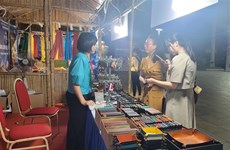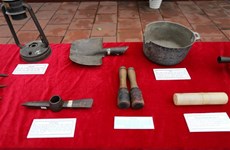Conference highlights Vietnam’s sovereignty over Hoang Sa, Truong Sa
The use of legal and historical evidence in line with international law
to solve sovereignty disputes related to Hoang Sa (Paracel) and Truong
Sa (Spratly) archipelagos is important to maintaining peace, stability
and ensuring free navigation in the East Sea.
The use of legal and historical evidence in line with international law
to solve sovereignty disputes related to Hoang Sa (Paracel) and Truong
Sa (Spratly) archipelago is important to maintaining peace, stability
and ensuring free navigation in the East Sea.
This was affirmed by many domestic and foreign researchers, attending the “Hoang Sa-Truong Sa: Historical Truth” international conference held in the central city of Da Nang on June 20.
All acts of deliberate use of force by any countries to cause insecurity and violate sovereignty and territory of other countries with an intention of monopolising the East Sea is unacceptable, they said.
Participants said that China’s act of using force to invade Hoang Sa archipelago in 1974 and illegally occupy several islands in Truong Sa archipelago in 1988 violated international law and the United Nations Charter.
Many also criticised China’s unlawful “nine-dash line” claim in the East Sea, which was promulgated in 2009, saying that this is extremely vague and totally illegal, and runs counter to provisions of international law and the 1982 United Nations Convention on the Law of the Sea (1982 UNCLOS), causing instability and tensions in the sea.
They also called on concerned countries to determine their waters in line with the provision in the 1982 UNCLOS, and take it as a basis to settle disputes in the East Sea.
Participants focused on analysing historical and legal evidence on sovereignty over Hoang Sa and Truong Sa archipelagoes, statements on Vietnam’s history on the archipelagos as well as Vietnam’s acts to safeguard the country’s sovereignty in accordance with international law.
Dr. Tran Duc Anh Son from the Da Nang Socio-economic Research and Development Institute publicised more than 100 bibliographies and over 140 old maps by western countries proving Vietnam’s sovereignty over Hoang Sa archipelago.-VNA
This was affirmed by many domestic and foreign researchers, attending the “Hoang Sa-Truong Sa: Historical Truth” international conference held in the central city of Da Nang on June 20.
All acts of deliberate use of force by any countries to cause insecurity and violate sovereignty and territory of other countries with an intention of monopolising the East Sea is unacceptable, they said.
Participants said that China’s act of using force to invade Hoang Sa archipelago in 1974 and illegally occupy several islands in Truong Sa archipelago in 1988 violated international law and the United Nations Charter.
Many also criticised China’s unlawful “nine-dash line” claim in the East Sea, which was promulgated in 2009, saying that this is extremely vague and totally illegal, and runs counter to provisions of international law and the 1982 United Nations Convention on the Law of the Sea (1982 UNCLOS), causing instability and tensions in the sea.
They also called on concerned countries to determine their waters in line with the provision in the 1982 UNCLOS, and take it as a basis to settle disputes in the East Sea.
Participants focused on analysing historical and legal evidence on sovereignty over Hoang Sa and Truong Sa archipelagoes, statements on Vietnam’s history on the archipelagos as well as Vietnam’s acts to safeguard the country’s sovereignty in accordance with international law.
Dr. Tran Duc Anh Son from the Da Nang Socio-economic Research and Development Institute publicised more than 100 bibliographies and over 140 old maps by western countries proving Vietnam’s sovereignty over Hoang Sa archipelago.-VNA













